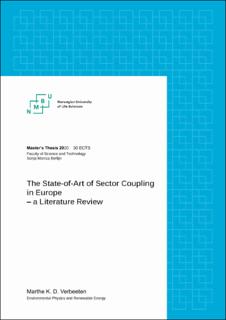| dc.contributor.advisor | Berlijn, Sonja Monica | |
| dc.contributor.advisor | Nygård, Heidi Samuelsen | |
| dc.contributor.author | Verbeeten, Marthe Karin Dorothee | |
| dc.coverage.spatial | Europe | en_US |
| dc.date.accessioned | 2020-09-21T08:43:53Z | |
| dc.date.available | 2020-09-21T08:43:53Z | |
| dc.date.issued | 2020 | |
| dc.identifier.uri | https://hdl.handle.net/11250/2678695 | |
| dc.description.abstract | At the same time as climate change pushes us to move away from fossil fuels, increasing amounts of energy from variable renewable sources are entering the grid. This requires structural transitions, to bring more flexibility and agility into the grid. The Paris Agreement and The European Green Deal show political willingness to support such a transitions. The question remains, how should we approach these transitions? One possibility is sector coupling: a strategy to couple sectors such as power, gas, and transport to increase both flexibility and profitability. This is achieved through the integration of otherwise normally non-integrable power into the energy system, through demand side management or through the adaptation of loads to also act as power generators.
In this thesis, term origins and the working definitions of sector coupling have been examined. The technologies involved have been outlined and their readiness levels have been assessed. The focus has been on the coupling of the electric power sector with the heating/cooling sector, the mobility sector and the gas sector in addition to the engagement of storage options.
Two literature searches were undertaken. The first focused on sector coupling as a whole, and found 94 publications. The second was aimed at the technologies involved in sector coupling and resulted in 96 publications. Five publications, each describing one type of technology, were chosen for in-depth analysis, together with five related illustrative cases.
The analysis of the first search shows that this topic is attracting increasing interest and that most research is presently done in Germany.
In the technology search, five technologies emerged as prominent. These were: batteries; power-to-heat with thermal storage; district heating with heat pumps; vehicle-to-grid; and power-to-gas.
The analysis shows that much of the needed technology is already at a high level of readiness. This, together with political willingness, gives sector coupling a strong foundation for further development. What is lacking is the market model for the flexibility suppliers and smart control arrangements for all the coupled technologies.
Further research should include: the definition and quantification of the need for more flexibility in the grid; a definitive standardisation of flexibility as a term in use; and a market model for the changes implicit in the introduction of more flexibility. | en_US |
| dc.description.abstract | Global oppvarming tvinger oss til å gjøre et skifte fra fossile til fornybare energikilder. Dette medfører at økende andel variabel kraft blir tilført og som øker kraftnettets behov for fleksibilitet. Parisavtalen og European Green Deal viser at det er politisk villighet til å støtte dette skiftet, men det rår usikkerhet over er hvordan dette skal gjennomføres. En mulighet er sektorkobling, som er en strategi for å koble sektorene sånn som kraft, transport og gas for å øke både fleksibilitet og lønnsomhet. Dette oppnås ved å integrere ellers ikke-integrerbar kraft i energisystemet, ved styrt etterspørsel eller ved å tilpasse laster slik at de også kan fungere som strømkilder.
I denne masteroppgaven blir begrepsopprinnelsen og fungerende definisjoner studert. De involverte teknologiene blir kartlagt og hvor langt unna de er implementering blir vurdert. Oppgaven fokuserer på hvordan kraftsystemet kan kobles med oppvarming/kjøling, transport og gass-sektoren i tillegg til lagringsmuligheter for energi. | en_US |
| dc.language.iso | eng | en_US |
| dc.publisher | Norwegian University of Life Sciences, Ås | en_US |
| dc.rights | Attribution-NonCommercial-NoDerivatives 4.0 Internasjonal | * |
| dc.rights.uri | http://creativecommons.org/licenses/by-nc-nd/4.0/deed.no | * |
| dc.subject | Power systems | en_US |
| dc.subject | Energy systems | en_US |
| dc.title | The state-of-art of sector coupling in Europe : a literature review | en_US |
| dc.title.alternative | Tilstandsrapport for sektorkobling i Europa : et litteraturstudie | en_US |
| dc.type | Master thesis | en_US |
| dc.subject.nsi | VDP::Technology: 500 | en_US |
| dc.source.pagenumber | 54 | en_US |
| dc.description.localcode | M-MF | en_US |

